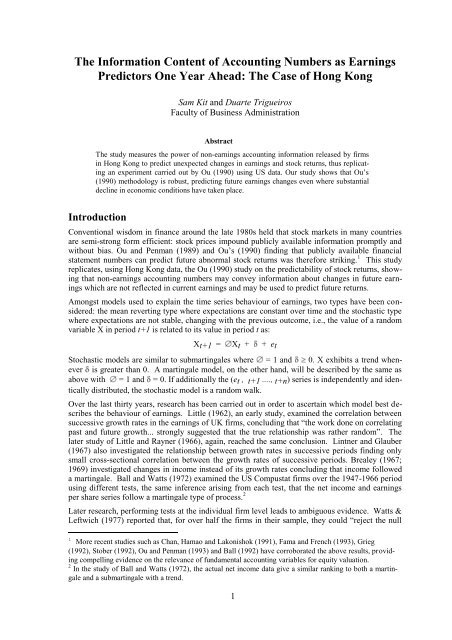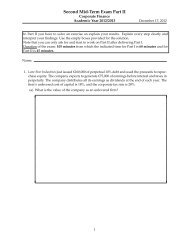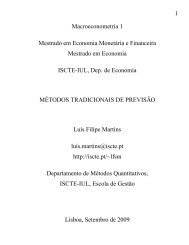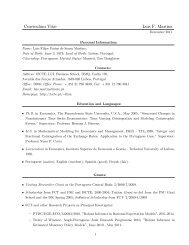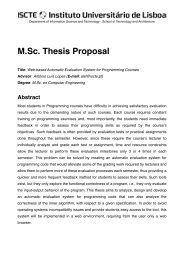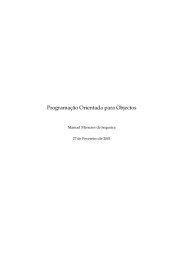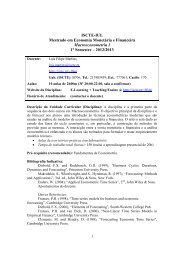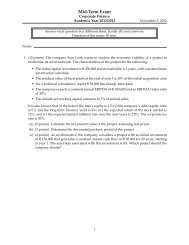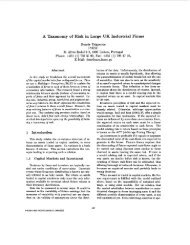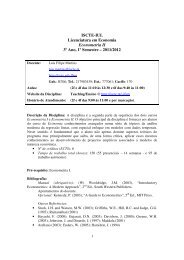The Information Content of Accounting Numbers as Earnings ...
The Information Content of Accounting Numbers as Earnings ...
The Information Content of Accounting Numbers as Earnings ...
You also want an ePaper? Increase the reach of your titles
YUMPU automatically turns print PDFs into web optimized ePapers that Google loves.
<strong>The</strong> <strong>Information</strong> <strong>Content</strong> <strong>of</strong> <strong>Accounting</strong> <strong>Numbers</strong> <strong>as</strong> <strong>Earnings</strong><br />
Predictors One Year Ahead: <strong>The</strong> C<strong>as</strong>e <strong>of</strong> Hong Kong<br />
Sam Kit and Duarte Trigueiros<br />
Faculty <strong>of</strong> Business Administration<br />
Abstract<br />
<strong>The</strong> study me<strong>as</strong>ures the power <strong>of</strong> non-earnings accounting information rele<strong>as</strong>ed by firms<br />
in Hong Kong to predict unexpected changes in earnings and stock returns, thus replicating<br />
an experiment carried out by Ou (1990) using US data. Our study shows that Ou’s<br />
(1990) methodology is robust, predicting future earnings changes even where substantial<br />
decline in economic conditions have taken place.<br />
Introduction<br />
Conventional wisdom in finance around the late 1980s held that stock markets in many countries<br />
are semi-strong form efficient: stock prices impound publicly available information promptly and<br />
without bi<strong>as</strong>. Ou and Penman (1989) and Ou’s (1990) finding that publicly available financial<br />
statement numbers can predict future abnormal stock returns w<strong>as</strong> therefore striking. 1 This study<br />
replicates, using Hong Kong data, the Ou (1990) study on the predictability <strong>of</strong> stock returns, showing<br />
that non-earnings accounting numbers may convey information about changes in future earnings<br />
which are not reflected in current earnings and may be used to predict future returns.<br />
Amongst models used to explain the time series behaviour <strong>of</strong> earnings, two types have been considered:<br />
the mean reverting type where expectations are constant over time and the stoch<strong>as</strong>tic type<br />
where expectations are not stable, changing with the previous outcome, i.e., the value <strong>of</strong> a random<br />
variable X in period t+1 is related to its value in period t <strong>as</strong>:<br />
Xt+1 = Xt + + et<br />
Stoch<strong>as</strong>tic models are similar to submartingales where = 1 and 0. X exhibits a trend whenever<br />
is greater than 0. A martingale model, on the other hand, will be described by the same <strong>as</strong><br />
above with = 1 and = 0. If additionally the (et , t+1 ...., t+n) series is independently and identically<br />
distributed, the stoch<strong>as</strong>tic model is a random walk.<br />
Over the l<strong>as</strong>t thirty years, research h<strong>as</strong> been carried out in order to <strong>as</strong>certain which model best describes<br />
the behaviour <strong>of</strong> earnings. Little (1962), an early study, examined the correlation between<br />
successive growth rates in the earnings <strong>of</strong> UK firms, concluding that “the work done on correlating<br />
p<strong>as</strong>t and future growth... strongly suggested that the true relationship w<strong>as</strong> rather random”. <strong>The</strong><br />
later study <strong>of</strong> Little and Rayner (1966), again, reached the same conclusion. Lintner and Glauber<br />
(1967) also investigated the relationship between growth rates in successive periods finding only<br />
small cross-sectional correlation between the growth rates <strong>of</strong> successive periods. Brealey (1967;<br />
1969) investigated changes in income instead <strong>of</strong> its growth rates concluding that income followed<br />
a martingale. Ball and Watts (1972) examined the US Compustat firms over the 1947-1966 period<br />
using different tests, the same inference arising from each test, that the net income and earnings<br />
per share series follow a martingale type <strong>of</strong> process. 2<br />
Later research, performing tests at the individual firm level leads to ambiguous evidence. Watts &<br />
Leftwich (1977) reported that, for over half the firms in their sample, they could “reject the null<br />
1<br />
More recent studies such <strong>as</strong> Chan, Hamao and Lakonishok (1991), Fama and French (1993), Grieg<br />
(1992), Stober (1992), Ou and Penman (1993) and Ball (1992) have corroborated the above results, providing<br />
compelling evidence on the relevance <strong>of</strong> fundamental accounting variables for equity valuation.<br />
2 In the study <strong>of</strong> Ball and Watts (1972), the actual net income data give a similar ranking to both a martingale<br />
and a submartingale with a trend.<br />
1
hypothesis that the estimated process is no different from a random walk at the 0.05 level”. Albrecht,<br />
Lookabill & McKeown (1977) reported a similar result. Departures from random walk are<br />
reported only when researchers adopt sample stratification analysis. Brooks and Buckm<strong>as</strong>ter<br />
(1976; 1980) examined a sample <strong>of</strong> US Compustat firms, stratifying their sample by the magnitude<br />
<strong>of</strong> the previous year’s earnings change. <strong>The</strong>y concluded that “a large relative incre<strong>as</strong>e in income is<br />
generally followed by two or more periods when the firm underperforms the average or most likely<br />
outcome. Likewise, a firm with a large relative decre<strong>as</strong>e in income generally outperforms the average<br />
or most likely outcome for two or more periods following the large incre<strong>as</strong>e”. This result<br />
h<strong>as</strong> been reported in other studies, for example, Beaver, Lambert & Morse (1980) and Freeman,<br />
Ohlson & Penman (1982).<br />
Instead <strong>of</strong> pursuing the path adopted by most researchers, Ou and Penman (1989) and Ou (1990)<br />
used non-earnings accounting numbers to predict earnings changes one year ahead. <strong>The</strong>ir results<br />
provide evidence for both a “predictive information link” between some non-earnings annual report<br />
numbers and future earnings changes and a “valuation link” between predicted future earnings<br />
changes and stock returns during the annual report dissemination period. 3 <strong>The</strong> predictive information<br />
link stems from fitting binary one-year-ahead earnings prediction models to selected annual<br />
report data and comparing these models’ prediction power with that <strong>of</strong> a random walk.<br />
Ou’s (1990) results also provide an additional explanation for a result reported in Ball and Brown<br />
(1968). <strong>The</strong>se authors noticed that the information on reported earnings is anticipated by the market<br />
<strong>as</strong> early <strong>as</strong> 12 months prior to the preliminary earnings announcement. <strong>The</strong>y speculate that<br />
other news events, such <strong>as</strong> dividend and interim earnings announcements, might explain why “unexpected<br />
earnings” are anticipated. <strong>The</strong> predictive information link documented in Ou’s (1990)<br />
study suggests that the rele<strong>as</strong>e <strong>of</strong> the previous year’s complete annual report, an event included in<br />
Ball and Brown’s (1968) abnormal return accumulation period, provides useful information for<br />
forming expectations about the current year’s earnings.<br />
Ou (1990) used a dichotomous variable to predict the sign <strong>of</strong> the change in one-year-ahead earnings,<br />
i.e., an earnings incre<strong>as</strong>e or an earnings decre<strong>as</strong>e. A change in firm i’s earnings in year t+1,<br />
denoted EPSit+1 is calculated <strong>as</strong>:<br />
EPSit+1 = (EPSit+1 - EPSit) - driftit<br />
where EPSit+1 and EPSit are firm i’s “<strong>as</strong> reported” earnings per share before extraordinary items<br />
for years t+1 and t, respectively. <strong>The</strong> drift term for year t is defined <strong>as</strong> the mean earnings per share<br />
change over the four years prior to year t and is required for eliminating any apparent trend in<br />
earnings. EPSit+1 is thus an unexpected change. After fitting univariate logit models for 61 financial<br />
ratios potentially useful <strong>as</strong> predictor candidates, only 8 such descriptors, with an estimated<br />
coefficient significant at the 10% level, were retained. <strong>The</strong>n multivariate logit models were used<br />
for these descriptors to find appropriate models. <strong>The</strong>se descriptors are:<br />
(1) % INVTA: percentage change in the “inventory to total <strong>as</strong>sets” ratio;<br />
(2) % SALTA: percentage growth in the “net sales to total <strong>as</strong>sets” ratio;<br />
(3) % DPS: change in “dividends per share”, relative to that <strong>of</strong> the previous year;<br />
(4) % DEP: percentage growth in “depreciation expense”;<br />
(5) % CPXTA1: percentage growth in the “capital expenditure to total <strong>as</strong>sets” ratio;<br />
(6) % CPXTA2: % CPXTA1, with a one-year lag;<br />
3 In this framework, the observed contemporaneous <strong>as</strong>sociation between accounting data and stock prices is<br />
the result <strong>of</strong> an “information link” between accounting data and future streams <strong>of</strong> benefits from equity investments<br />
and a “valuation link” between future benefits and stock prices. <strong>Information</strong> disclosure triggers<br />
revisions <strong>of</strong> investors’ expectation <strong>of</strong> the future benefits. <strong>The</strong>se revisions are then reflected in current stock<br />
prices. This framework is formally presented in Ohlson (1979) and Garman and Ohlson (1980), and empirically<br />
tested by E<strong>as</strong>ton (1985).<br />
2
(7) ROE: rate <strong>of</strong> return on equity (income before extraordinary items” divided by total<br />
owners’ equity <strong>as</strong> <strong>of</strong> the beginning <strong>of</strong> the year);<br />
(8) ROE: change in ROE, relative to the previous year’s ROE.<br />
Using the above eight ratios, Ou (1990) then constructed three multivariate prediction models:<br />
Model 1, b<strong>as</strong>ed on all eight accounting predictors; Model 2, b<strong>as</strong>ed on six accounting predictors<br />
excluding ROE & % ROE; and Model 3, b<strong>as</strong>ed on ROE only.<br />
<strong>The</strong> predictive performance for each <strong>of</strong> the above models during the period 1978-1983 w<strong>as</strong> then<br />
examined. <strong>The</strong> output <strong>of</strong> the model is an estimated probability <strong>of</strong> an earnings incre<strong>as</strong>e in the subsequent<br />
year. To translate each probabilistic prediction into a binary prediction <strong>of</strong> an earnings incre<strong>as</strong>e<br />
or decre<strong>as</strong>e, Ou (1990) used two pre-set probability cut-<strong>of</strong>f schemes: (0.5, 0.5) and (0.6,<br />
0.4). Under the (0.5, 0.5) scheme, the prediction is an earnings incre<strong>as</strong>e when the probability is<br />
greater than 0.5 and a decre<strong>as</strong>e otherwise. Alternatively, under the (0.6, 0.4) scheme, the prediction<br />
is an earnings incre<strong>as</strong>e when the probability is greater than or equal to 0.6 and a decre<strong>as</strong>e<br />
when the probability is less than or equal to 0.4; observations with probability between 0.6 and 0.4<br />
are discarded. Each <strong>of</strong> the three logit models had a prediction accuracy higher than 50% (i.e., 61%,<br />
58% and 58% for Models 1, 2 and 3 respectively under the (0.5, 0.5) scheme). <strong>The</strong> performance<br />
substantially improved when the (0.6, 0.4) cut<strong>of</strong>f scheme w<strong>as</strong> used.<br />
Data and Methodology<br />
Similar to Ou’s (1990), this study approximates “unexpected earnings” in the specification <strong>of</strong> earnings<br />
changes under a submartingale process. That is, the earnings change is defined <strong>as</strong> the difference<br />
in two consecutive years’ earnings per share, net <strong>of</strong> estimated drift. <strong>Accounting</strong> information<br />
used in our study is extracted from an annual Pacific-B<strong>as</strong>in Capital Markets (PACAP) Datab<strong>as</strong>e<br />
for the period 1985-1993 4 . Only firms not involved in banking, finance and insurance, with financial<br />
statement figures stated in HKD and USD have been chosen. <strong>The</strong> number <strong>of</strong> firms included in<br />
samples varies from year to year, incre<strong>as</strong>ing from about 215 in 1985 to 361 in 1993. Most <strong>of</strong> the<br />
Hong Kong firms do not disclose information on Cost <strong>of</strong> Goods Sold (and consequently Gross<br />
Margin) <strong>as</strong> they consider such information confidential and subject to usage by competitors.<br />
<strong>The</strong>refore, computation <strong>of</strong> ratios related to such items cannot possibly be made even though Ou<br />
and Penman (1989) h<strong>as</strong> used Gross Margin <strong>as</strong> the component predictor in their earnings prediction<br />
model. Three other ratios also impossible to compute in our c<strong>as</strong>e are Percentage Change in Depreciation<br />
(% DEP), Percentage Change in Capital Expenditure to Total Assets (% CPXTA1) and<br />
Percentage Change in Capital Expenditure to Total Assets with a one-year lag (% CPXTA2) due<br />
to the fact that Depreciation and Capital Expenditure are not available in the PACAP datab<strong>as</strong>e.<br />
<strong>The</strong>se three ratios are also predictors in Ou’s (1990) models. Another problem encountered in our<br />
study is the fact that a significant number <strong>of</strong> Hong Kong firms have zero inventory figures. This is<br />
typical <strong>of</strong> firms such <strong>as</strong> shipping, property development and other services. Accordingly, ratios<br />
related to Inventory were excluded from the analysis. One other ratio removed from the model due<br />
to the large amount <strong>of</strong> missing c<strong>as</strong>es is Percentage Change in Dividend Per Share (% DPS).<br />
Except in the c<strong>as</strong>e <strong>of</strong> those ratios close to normality, we applied symmetrical logarithm transformations<br />
to eliminate skewness, reduce the number <strong>of</strong> outliers and subdue heterosced<strong>as</strong>ticity. <strong>The</strong><br />
multivariate statistical technique employed in our study to build the empirical models is discriminant<br />
analysis. We avoided using logit regression <strong>as</strong> such tool implicitly incorporate group proportions<br />
<strong>as</strong> present in samples in the estimation <strong>of</strong> the predicted probabilities. If, for example, firms<br />
exhibiting positive earnings changes are more frequent in the sample than those having negative<br />
changes, then the logistic model is bi<strong>as</strong>ed towards more e<strong>as</strong>ily recognising positive changes. Discriminant<br />
analysis separates the calculation <strong>of</strong> conditional probabilities from the introduction <strong>of</strong><br />
non-equal priors.<br />
4 <strong>The</strong> PACAP datab<strong>as</strong>e is developed by the Sandra Ann Morsilli Pacific-B<strong>as</strong>in Capital Markets Research<br />
Centre, in the College <strong>of</strong> Business Administration at the University <strong>of</strong> Rhode Island (USA) and is updated<br />
annually. We extend this history back to 1981 because <strong>of</strong> the requirement to estimate an earnings drift parameter<br />
over four years. Note, however, that the earnings prediction model is estimated using data from<br />
1985 onwards.<br />
3
Furthermore, we consider that what Ou (1990) describes <strong>as</strong> different cut-<strong>of</strong>f probability schemes<br />
(0.5, 0.5) and (0.6, 0.4) is tantamount to introducing in the outcome, besides the bi<strong>as</strong> referred to<br />
above, yet another arbitrary set <strong>of</strong> a-priori probabilities. Ou’s (1990) cut-<strong>of</strong>f <strong>of</strong> 0.6 means that an<br />
explicit prior probability is added to the logistic output. This renders the model more sensitive to<br />
upwards earnings changes. Similarly, the cut-<strong>of</strong>f <strong>of</strong> 0.4 means that a second prior judgement, contradictory<br />
with the first, is added to the logistic regression output. Sensitivity to downwards<br />
changes also incre<strong>as</strong>es. <strong>The</strong> extra power <strong>of</strong> the models may thus reflect the above prior judgements.<br />
In order to illustrate the potential for unbalancing models which the use <strong>of</strong> non-equal priors<br />
entails, our results are replicated using unbalanced sets <strong>of</strong> priors.. Thus, in our c<strong>as</strong>e, the output <strong>of</strong><br />
the discriminant model, a Z-score, is translated into a binary prediction <strong>of</strong> an earnings incre<strong>as</strong>e or<br />
decre<strong>as</strong>e, using two sets <strong>of</strong> prior probability schemes (0.5, 0.5) and (0.6, 0.4). Under the (0.5, 0.5)<br />
scheme, earnings decre<strong>as</strong>es are a-priori considered <strong>as</strong> equally likely <strong>as</strong> earnings incre<strong>as</strong>es. Under<br />
the (0.6, 0.4) scheme, earnings incre<strong>as</strong>es are considered, a-priori, more likely, thus models are<br />
more sensitive to positive earnings changes.<br />
Model’s results must be validated by me<strong>as</strong>uring its performance in a different data set. Ou (1990)<br />
divided her data set in two periods, 1965-77 and 1978-83, using the first period to build the earnings<br />
prediction model and testing its performance in the second period. However, Freeman et al.<br />
(1982) suggest that the economy, namely macro-economic variables, may have explanatory power<br />
in predicting earnings changes. <strong>The</strong> predictive power claimed by Ou (1990) might then stem from<br />
smoothed economic conditions, not just from genuine accounting information. In our study, the<br />
hypothesis that the economy may interfere with accounting information is made explicit by choosing<br />
the period 1985-88 to build models and the period 1989-93 to test them. <strong>The</strong> first <strong>of</strong> such periods<br />
presents economic conditions which are opposed to those in the second.<br />
Results<br />
Predictive <strong>Information</strong> Link: when we refer to the predictive performance <strong>of</strong> a particular year, it<br />
means that the non-earnings accounting variables <strong>of</strong> that year are used to predict the earnings<br />
changes for the subsequent year. Ratios with overall explanatory power are (Table 1):<br />
Table 1.<br />
Discriminant Two-Period <strong>Earnings</strong> Prediction Model (1985-1988)<br />
Financial Ratios Abbreviation Standardised Coefficient<br />
Dividend per Share DPS +0.63<br />
Sales to Total Assets SALTA +0.52<br />
% Change in Sales to Total Assets % SALTA -0.34<br />
C<strong>as</strong>h to Sales CSHSAL +0.27<br />
Return on Total Assets RTA -0.18<br />
<strong>The</strong> magnitude <strong>of</strong> the standardised coefficient shows the relative explanatory importance <strong>of</strong> each<br />
ratio. A highly significant Chi-Square <strong>of</strong> 45.5 w<strong>as</strong> obtained when estimating the overall fitness <strong>of</strong><br />
the model. Univariate F-ratios <strong>of</strong> each <strong>of</strong> the above predictors are significant, at le<strong>as</strong>t at the 0.05<br />
level, except in the c<strong>as</strong>e <strong>of</strong> C<strong>as</strong>h to Sales (CSHSAL), which is non-significant. However, when<br />
removing this variable from the analysis, a significant break in the overall Chi-Square and performance<br />
is observed. <strong>The</strong> above illustrates just how elusive univariate screening techniques can<br />
be. <strong>The</strong> performance obtained in the test period is 58%, distributed <strong>as</strong> follows (<br />
Table 2):<br />
4
Table 2.<br />
Predictive Performance <strong>of</strong> Two-Period <strong>Earnings</strong> Prediction Model Without Prior Probability<br />
As Predicted<br />
Actual Group<br />
Downwards EPS<br />
Changes<br />
Upwards EPS<br />
Changes<br />
Total No. <strong>of</strong><br />
C<strong>as</strong>es<br />
Downwards EPS Changes 212 (58%) 157 369<br />
Upwards EPS Changes 152 209 (58%) 361<br />
Total No. <strong>of</strong> C<strong>as</strong>es 364 366 730<br />
<strong>Numbers</strong> refer to c<strong>as</strong>es falling inside each cl<strong>as</strong>sification group<br />
<strong>The</strong> model is balanced (the proportion <strong>of</strong> upwards earnings changes correctly cl<strong>as</strong>sified is similar<br />
to the corresponding proportion <strong>of</strong> downwards changes).<br />
When, in the same c<strong>as</strong>e, different prior probabilities are introduced to translate Z-Scores into cl<strong>as</strong>sifications<br />
results, the balance referred to above is strongly affected. <strong>The</strong> overall performance is<br />
55% and, in detail (Table 3):<br />
Table 3.<br />
Predictive Performance, Prior Probability 0.4 And 0.6<br />
As Predicted<br />
Actual Group<br />
Downwards Upwards EPS Total No. <strong>of</strong> C<strong>as</strong>es<br />
EPS Changes Changes<br />
Downwards EPS Changes 87 (24%) 282 369<br />
Upwards EPS Changes 48 313 (87%) 361<br />
Total No. <strong>of</strong> C<strong>as</strong>es 135 595 730<br />
<strong>The</strong> above strong imbalance between upwards and downwards performance is obtained by introducing<br />
just a small amount <strong>of</strong> prior information: p=0.6 for upwards and p=0.4 for downwards. On<br />
a yearly b<strong>as</strong>is, the prediction model performs <strong>as</strong> follows (Table 4):<br />
Table 4.<br />
Yearly Performance by year<br />
Prior Probability<br />
Total No. (0.5, 0.5) (0.6, 0.4)<br />
Year <strong>of</strong> C<strong>as</strong>es Correct Prediction Correct Prediction<br />
No. <strong>of</strong> C<strong>as</strong>es % No. <strong>of</strong> C<strong>as</strong>es %<br />
1989 160 93 58% 83 52%<br />
1990 166 94 57% 87 52%<br />
1991 196 110 56% 115 59%<br />
1992 208 124 60% 115 55%<br />
Overall 730 421 58% 400 55%<br />
Under the (0.5, 0.5) scheme, the percentage <strong>of</strong> correct predictions ranges from 56% to 60%. When<br />
priors (0.6, 0.4) are used, prediction accuracy improves for year 1991 instead <strong>of</strong> for all years <strong>as</strong> in<br />
Ou’s (1990) study. <strong>The</strong> results indicate that the superiority <strong>of</strong> the model over the random-guess<br />
strategy is consistent across individual years. Table 5 and 6 are further breakdowns <strong>of</strong> the correct<br />
prediction where subsequent earnings changes are a decre<strong>as</strong>e or an incre<strong>as</strong>e.<br />
5
Table 5.<br />
Yearly Performance When Subsequent <strong>Earnings</strong> Changes are a Decre<strong>as</strong>e<br />
Prior Probability<br />
Total No. (0.5, 0.5) (0.6, 0.4)<br />
Year <strong>of</strong> C<strong>as</strong>es Correct Prediction Correct Prediction<br />
No. <strong>of</strong> C<strong>as</strong>es % No. <strong>of</strong> C<strong>as</strong>es %<br />
1989 79 45 57% 17 22%<br />
1990 85 49 58% 19 22%<br />
1991 98 52 53% 25 26%<br />
1992 107 66 62% 26 24%<br />
Overall 369 212 58% 87 24%<br />
Table 6.<br />
Yearly Performance When Subsequent <strong>Earnings</strong> Changes are an Incre<strong>as</strong>e<br />
Prior Probability<br />
Total No. (0.5, 0.5) (0.6, 0.4)<br />
Year <strong>of</strong> C<strong>as</strong>es Correct Prediction Correct Prediction<br />
No. <strong>of</strong> C<strong>as</strong>es % No. <strong>of</strong> C<strong>as</strong>es %<br />
1989 81 48 59% 66 81%<br />
1990 81 45 56% 68 84%<br />
1991 98 58 59% 90 92%<br />
1992 101 58 57% 89 88%<br />
Overall 361 209 58% 313 87%<br />
Under the (0.5, 0.5) scheme <strong>of</strong> the two-period model, the predictive power from year to year for<br />
downwards earnings changes shows more variability (between 53% and 62%) than for upwards<br />
earnings changes (between 56% and 59%). When prior probability (0.6, 0.4) is used, the correction<br />
prediction rate is only 22% to 26% for downwards earnings changes but 81% to 92% for upwards<br />
earnings changes.<br />
Valuation Link: this study also investigates the link between predicted earnings changes and the<br />
behaviour <strong>of</strong> prices in the Hong Kong stock market. Following Ou (1990), the annual report <strong>of</strong><br />
year t is viewed <strong>as</strong> containing two signals: First, signal E indicates the direction <strong>of</strong> changes in earnings<br />
in the current year (t). Second, signal F (forec<strong>as</strong>t) corresponds to the possibility <strong>of</strong> investors<br />
forec<strong>as</strong>ting next year’s (t+1) earnings changes.<br />
<strong>The</strong> above discriminant model is used to forec<strong>as</strong>t the changes in earnings during the period 1988-<br />
92. Two sets <strong>of</strong> firms are obtained: F+ firms with a forec<strong>as</strong>ted positive change in earnings and F-<br />
with a negative forec<strong>as</strong>t. <strong>The</strong>n, four portfolios are formed: portfolio E+F+, containing firms having<br />
positive E and F signals; and similarly, portfolio E+F-, E-F+ and E-F-. Finally, the relative<br />
performance <strong>of</strong> each <strong>of</strong> these portfolios in the stock market is compared using the comulative abnormal<br />
return (CAR) me<strong>as</strong>urement, calculated monthly from April <strong>of</strong> year t until March <strong>of</strong> year<br />
t+1. 5 <strong>The</strong> CAR <strong>of</strong> a portfolio held from month m to month n (both relative to month 0) h<strong>as</strong> the<br />
form: CAR mn = 1/N t i m to n (1 + e ist ) - 1 where e ist is the market model residual <strong>of</strong><br />
month s for firm i in year t and N is the total number <strong>of</strong> firm-year observations in each portfolio.<br />
Both monthly returns and the index used <strong>as</strong> the independent variable in market model regressions<br />
were extracted from the same PACAP datab<strong>as</strong>e. Only 50 firms having fiscal year end on December<br />
were selected, yielding a total <strong>of</strong> 250 different c<strong>as</strong>es. <strong>The</strong> obtained CAR for each month are displayed<br />
on Table 7 and in figure 1.<br />
Table 7.<br />
Comulative Abnormal Returns (CAR) for Portfolios and Overall<br />
Month All Firms E-F- E+F- E-F+ E+F+<br />
April 0.003 0.004 0.009 -0.002 0.003<br />
5 See, e.g., Ball & Brown (1968), Ou (1990), or other texts on the absorption <strong>of</strong> information by capital markets<br />
for more details. Notice that, in our c<strong>as</strong>e, CARs, not APIs (abnormal performance indices), were used.<br />
6
May 0.022 0.024 0.040 0.015 0.030<br />
June 0.014 0.002 0.035 -0.005 0.028<br />
July 0.005 -0.024 0.033 -0.034 0.024<br />
August 0.001 -0.035 0.029 -0.042 0.022<br />
September 0.009 -0.045 0.048 -0.049 0.044<br />
October 0.007 -0.069 0.064 -0.077 0.055<br />
November 0.015 -0.063 0.073 -0.068 0.068<br />
December 0.021 -0.070 0.086 -0.071 0.085<br />
January 0.025 -0.071 0.095 -0.072 0.094<br />
February 0.023 -0.071 0.084 -0.066 0.089<br />
March 0.039 -0.063 0.100 -0.050 0.118<br />
This result shows that, also in Hong Kong, investors use forec<strong>as</strong>ts <strong>of</strong> changes in earnings, b<strong>as</strong>ed on<br />
accounting information, to price quoted firms. Indeed, during the annual report dissemination period<br />
(January to March <strong>of</strong> year t+1), there is a change <strong>of</strong> behaviour in portfolios F+ and F- with regard<br />
to the performance b<strong>as</strong>ed solely on the information available for the current year (E+ or E).<br />
<strong>The</strong> differences from Ou’s (1990) results are that, in her c<strong>as</strong>e, such change takes place one month<br />
earlier and, in the c<strong>as</strong>e <strong>of</strong> bad news, there is no clear evidence <strong>of</strong> a post-annoncement period where<br />
investors take a significant amount <strong>of</strong> time to absorb such news.<br />
+.15<br />
+.10<br />
+.05<br />
Figure 1. Comulative Abnormal Returns<br />
E+F+<br />
E-F-<br />
E+F-<br />
0<br />
All Firms<br />
-.05<br />
E-F+<br />
-.10<br />
-.15<br />
April May June July Aug. Sept. Oct. Nov. Dec. Jan. Feb. March<br />
Conclusions<br />
This study h<strong>as</strong> replicated, in the Hong Kong context, a significant and well-known piece <strong>of</strong> research<br />
which digs straight into the problem <strong>of</strong> whether or not accounting numbers convey significant<br />
information to investors. Features <strong>of</strong> firms bearing significant predictive power were quite<br />
similar in Ou’s (1990) and in our models. For example, the Percentage Change in Sales to Total<br />
Assets (% SALTA) is exactly the same in both Ou’s (1990) and our models; the Rate <strong>of</strong> Return on<br />
Equity (ROE) in Ou’s (1990) models is similar to our Return on Assets (RTA).<br />
Our study confirms Ou’s b<strong>as</strong>ic intuition: the existence <strong>of</strong> a multivariate mechanism leading to the<br />
predictability <strong>of</strong> firm’s earnings, small <strong>as</strong> it may be, means that investors, also in Hong Kong, can<br />
obtain marginal information about future earnings changes. One major result <strong>of</strong> our study is the<br />
fact that Ou’s (1990) methodology seems to be b<strong>as</strong>ically robust in the presence <strong>of</strong> different economic<br />
patterns. In other words, accounting information may be used to predict, to a given extent,<br />
earnings changes one year ahead, irrespective <strong>of</strong> the economic mood. This result importantly suggests<br />
that, contrary to what happens in capital markets (where prices, in spite <strong>of</strong> reflecting investor’s<br />
expectations, are very sensitive to perv<strong>as</strong>ive economic forces and to specific or local events),<br />
accounting information is more sheltered from such disturbances.<br />
7
Bibliography<br />
Albrecht, W. L., Lookabill L. and McKeown, J. (1977). “<strong>The</strong> Time-Series Properties <strong>of</strong> Annual <strong>Earnings</strong>”,<br />
Journal <strong>of</strong> <strong>Accounting</strong> Research, Autumn, pp. 226-244.<br />
Ball, R. (1992). “<strong>The</strong> <strong>Earnings</strong>-Price Anomaly” Journal <strong>of</strong> <strong>Accounting</strong> and Economics, V. 15, pp. 159-78.<br />
Ball, R. and Brown, P. (1968). “An Empirical Evaluation <strong>of</strong> <strong>Accounting</strong> Income <strong>Numbers</strong>”, Journal <strong>of</strong> <strong>Accounting</strong><br />
Research, Autumn, pp. 159-178.<br />
Ball, R. and Watts, R. (1972). “Some Time Series Properties <strong>of</strong> <strong>Accounting</strong> Income”, Journal <strong>of</strong> Finance,<br />
June, pp. 663-681.<br />
Brealey, R. A. (1967). “Statistical Properties <strong>of</strong> Successive Changes in <strong>Earnings</strong>”, Working paper, Keystone<br />
Custodian Funds, March.<br />
Brealey, R. A. (1969). “An Introduction to Risk and Return from Common Stocks”, Boston, M.I.T. Press.<br />
Brooks, L. D. and Buckm<strong>as</strong>ter D. A. (1976). “Further Evidence <strong>of</strong> the Time-Series <strong>of</strong> <strong>Accounting</strong> Income”,<br />
Journal <strong>of</strong> Finance, December, pp. 1359-1373.<br />
Brooks, L. D. and Buckm<strong>as</strong>ter D. A. (1980). “First-Difference Signals and <strong>Accounting</strong> Income Time-Series<br />
Properties”, Journal <strong>of</strong> Business Finance and <strong>Accounting</strong>, Autumn, pp. 437-454.<br />
Chan, L., Yamao, Y. and Lakonishok (1991). “Fundamentals and Stock Returns in Japan”, Journal Finance,<br />
December, pp. 1739-1764.<br />
E<strong>as</strong>ton, P. (1985). “<strong>Accounting</strong> <strong>Earnings</strong> and Security Valuation: Empirical Evidence <strong>of</strong> the Fundamental<br />
Links”, Journal <strong>of</strong> <strong>Accounting</strong> Research, Supplement, pp. 54-77.<br />
Fama, E. and French K. (1993) “Size and Book to Market Factors in <strong>Earnings</strong> and Returns”, Working Paper,<br />
September.<br />
Freeman, R., Ohlson J. and Penman S. (1982). “Book Rate-<strong>of</strong>-Return and Predictions <strong>of</strong> <strong>Earnings</strong> Changes:<br />
An Empirical Investigation”, Journal <strong>of</strong> <strong>Accounting</strong> Research, Vol. 20, No. 2, pp. 639-653.<br />
Garman, M. and Ohlson, J. (1980). “<strong>Information</strong> and Sequential Valuation <strong>of</strong> Assets in Arbitrage-Free Economies”,<br />
Journal <strong>of</strong> <strong>Accounting</strong> Research, Autumn, pp. 420-440.<br />
Grieg, A. (1992). “Fundamental Analysis and Subsequent Stock Returns”, Journal <strong>of</strong> <strong>Accounting</strong> and Economics,<br />
Vol. 15, pp. 413-442.<br />
Lintner, J. and Glauber, R. (1967). “Higgledy Piggledy Growth in America”, Paper presented at the Seminar<br />
on the Analysis <strong>of</strong> Security Prices, University <strong>of</strong> Chicago, May 11-12.<br />
Little, I. M. D. (1962). “Higgledy Piggledy Growth”, Bulletin <strong>of</strong> the Oxford Institute <strong>of</strong> Economics and Statistics,<br />
November, pp. 387-412.<br />
Little, I. M. D. and Rayner, A. C. (1966). “Higgledy Piggledy Growth Again”, Oxford: B<strong>as</strong>il Blackwell.<br />
Ohlson, J. (1979). “Risk, Return, Security Valuation, and the Stoch<strong>as</strong>tic Behaviour <strong>of</strong> <strong>Accounting</strong> <strong>Numbers</strong>”,<br />
Journal <strong>of</strong> Financial and Quantitative Analysis, June, pp. 317-336.<br />
Ou, J. A. (1984). “<strong>The</strong> <strong>Information</strong> <strong>Content</strong> <strong>of</strong> Nonearnings <strong>Accounting</strong> <strong>Numbers</strong> <strong>as</strong> <strong>Earnings</strong> Predictors”,<br />
Ph.D. dissertation, University <strong>of</strong> California, Berkeley, 1984.<br />
Ou, J. A. (1990). “<strong>The</strong> <strong>Information</strong> <strong>Content</strong> <strong>of</strong> Nonearnings <strong>Accounting</strong> <strong>Numbers</strong> <strong>as</strong> <strong>Earnings</strong> Predictors”,<br />
Journal <strong>of</strong> <strong>Accounting</strong> Research, Vol. 28, No. 1, Spring, pp. 392-411.<br />
Ou, J. A. and Penman S. H. (1989) “Financial Statement Analysis and the Prediction <strong>of</strong> Stock Returns”,<br />
Journal <strong>of</strong> <strong>Accounting</strong> and Economics, Vol. 11, pp. 295-329.<br />
Ou, J. A. and Penman S. H. (1993) “Financial Statement Analysis and the Evaluation <strong>of</strong> Market to Book Ratios”,<br />
Working Paper, University <strong>of</strong> California at Berkley, August.<br />
Stober, T. (1992). “Summary Financial Statement Me<strong>as</strong>ures and Analysis”, Journal <strong>of</strong> <strong>Accounting</strong> and Economics,<br />
Vol. 15, pp. 347-372.<br />
Watts, R. and Leftwich, R. (1977). “<strong>The</strong> Time-Series Properties <strong>of</strong> Annual <strong>Earnings</strong>”, Journal <strong>of</strong> <strong>Accounting</strong><br />
Research, Autumn, pp. 253-271.<br />
8


